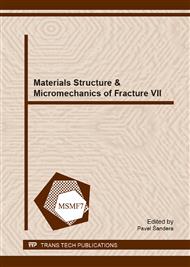p.761
p.765
p.769
p.773
p.777
p.781
p.785
p.789
p.793
PSBs and Non-Propagation of Small Surface and Interior Cracks in Polycrystalline Copper
Abstract:
PSB formation and its relevance for an eventual fatigue limit of polycrystalline electrolytic copper was studied in the very-high cycle fatigue regime with the ultrasound fatigue loading method. PSBs are formed at much lower stress/strain amplitudes than reported in earlier literature, if a high enough number of cycles is applied. Fatigue fracture takes place at approximately 50% higher amplitudes than needed for PSB formation, which is likewise in contrast to former literature results. Non-propagation of small cracks, originating from intrusions or PSB-induced non-propagating grain-boundary cracks are made responsible for this different material response.
Info:
Periodical:
Pages:
777-780
Citation:
Online since:
November 2013
Price:
Сopyright:
© 2014 Trans Tech Publications Ltd. All Rights Reserved
Share:
Citation:


